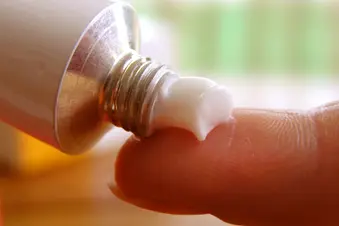
If your child has moderate to severe atopic dermatitis (AD), over-the-counter and home remedies might not cut it. AD is the most common type of eczema. It can cause severe skin rashes that may need strong treatments.
No one therapy works for all kids with eczema. You may have to try several options or use them in combination before symptoms ease.
Topical Treatments
Topical treatments are medicines that you rub onto your skin. Some options for kids with AD include:
Topical steroids: They are some of the most prescribed treatments for eczema. Steroids can lessen your child’s itching and inflammation. These medicines can also cause side effects, such as thinning skin, stretch marks, acne, rashes, or spider veins.
Ruxolitinib (Opzelura): Opzelura is a topical medicine that blocks specific enzymes, called JAK1 and JAK2, that can lead to AD. Stopping the effects of these enzymes can lessen itching, rashes, and skin redness. The FDA has approved Opzelura to treat children ages 12 and older whose AD is not controlled with other topical therapies. Some common side effects of Opzelura include
- Diarrhea
- Cold symptoms
- Bronchitis
- Ear infections
- Swollen tonsils
- Inflamed hair pores
- Eosinophilia (an increase in a certain type of white blood cell)
Topical calcineurin inhibitors (TCIs): These medicines stop certain cells in the immune system from turning on. This can prevent redness, itching, and inflammation. Tacrolimus (Protopic) is a topical TCI that’s approved for moderate to severe AD in children ages 2 to 15. Pimecrolimus (Elidel) is another topical TCI, and it’s FDA-approved for children ages 2 and older with mild to moderate AD. Common side effects of TCIs include mild burning or stinging when the medicine is applied.
Crisaborole (Eucrisa): Eucrisa blocks an enzyme called phosphodiesterase 4 (PDE4) that creates inflammatory reactions in the body. Eucrisa is a topical treatment approved for children ages 3 months and older with mild to moderate AD. Some common side effects of this medicine include pain, burning, or stinging.
Oral Medicines
Prescription oral medications for kids with AD include:
Antibiotics: If your child gets a skin infection, your doctor may prescribe an antibiotic to clear it up. Side effects are usually mild, but your child may have:
- Queasiness and vomiting
- Diarrhea
- Dizziness
- Rashes
- Yeast infections
Steroids: Doctors sometimes prescribe oral steroids as a short-term treatment for kids with severe AD. The use of steroids for longer than about a month can lead to serious side effects, such as:
- Mood swings and crankiness
- Weight gain
- Upset stomach
- Changes in blood sugar levels
- Infections
- Changes in bone growth or bone thinning
Antihistamines: Prescription-strength antihistamines may help ease your child’s itching. Antihistamines are generally safe but can cause
- Drowsiness
- Tiredness
- Dry mouth
- Headache
- Changes in vision
Immunosuppressant medicines: These drugs work by quieting the immune system. They aren’t approved by the FDA for AD, but doctors sometimes prescribe them “off-label” to treat severe cases.
Immunosuppressants can cause serious side effects, such as an increased risk for infections, high blood pressure, kidney damage, and liver damage. They are also known to cause upset stomach and vomiting.
Some examples of immunosuppressant drugs for kids include:
- Azathioprine (Azasan, Imuran)
- Cyclosporine (Gengraf, Neoral, Sandimmune)
- Methotrexate (Trexall, Rheumatrex)
- Mycophenolate mofetil (CellCept).
Upadacitinib (Rinvoq): Rinvoq is an oral JAK inhibitor that blocks the JAK1 enzyme. It’s FDA-approved for children ages 12 and older with moderate to severe AD that can’t be controlled with other medicines.
Biologics
Biologics are proteins made from living cells or tissues. They’re engineered to target parts of the immune system that trigger inflammation.
Biologics stop specific proteins called interleukins from binding to their receptors. This calms the immune system, which leads to fewer AD symptoms.
Dupilumab (Dupixent) is currently the only biologic medicine available for kids. The FDA has approved this medicine for children 6 months of age and older with moderate to severe AD who haven’t benefited from other treatments. You get Dupixent as a shot once every other week to every month, depending on your weight. The most common side effects are pinkeye, infections where you get the shot, and cold sores.
Phototherapy
Phototherapy is a treatment that uses ultraviolet (UV) light to stop the body’s response to inflammation. In kids, it can lessen itching, swelling, and redness.
This treatment is usually recommended if your child’s eczema covers their entire body or if certain eczema problem spots don’t get better with topical treatments.
During phototherapy treatments, a special machine will shine light on your child’s exposed skin. The treatment usually takes seconds or minutes to complete.
Phototherapy can cause side effects, such as burns, stinging skin, redness, or tenderness. Rarely, the treatment has been linked to the development of wrinkles, skin reactions, and skin cancer. Some types of phototherapy can also cause pigment issues in kids with darker skin tones.
Typically, children receive two to three phototherapy sessions a week. Treatments last for a few weeks or months.
Show Sources
Photo Credit: danielle71/Thinkstock
SOURCES:
National Eczema Association: “Atopic Dermatitis,” “Eczema Treatment for Children,” “Available Eczema Treatments,” “FAQ: Opzelura (Ruxolitinib) Cream,” “FAQ: Eucrisa (Crisaborole),” “Prescription Oral,” “Dupixent for Atopic Dermatitis FAQ,” “Prescription Phototherapy.”
American Academy of Dermatology Association: “When Your Child Needs Strong Medicine to Control Eczema,” “Eczema Treatment: Phototherapy.”
Mayo Clinic: “Atopic dermatitis (eczema).”
National Health Service (U.K.): “Antihistamines,” “Short-term steroid treatment.”
American Academy of Pediatrics: “How to Treat & Control Eczema Rashes in Children,” “Eczema (Atopic Dermatitis) and Your Child.”
Cleveland Clinic: “Antibiotics.”
FDA Prescribing Information: “Dupixent.”
Seminars in Cutaneous Medicine and Surgery: “Role of Phototherapy in Patients with Skin of Color.”